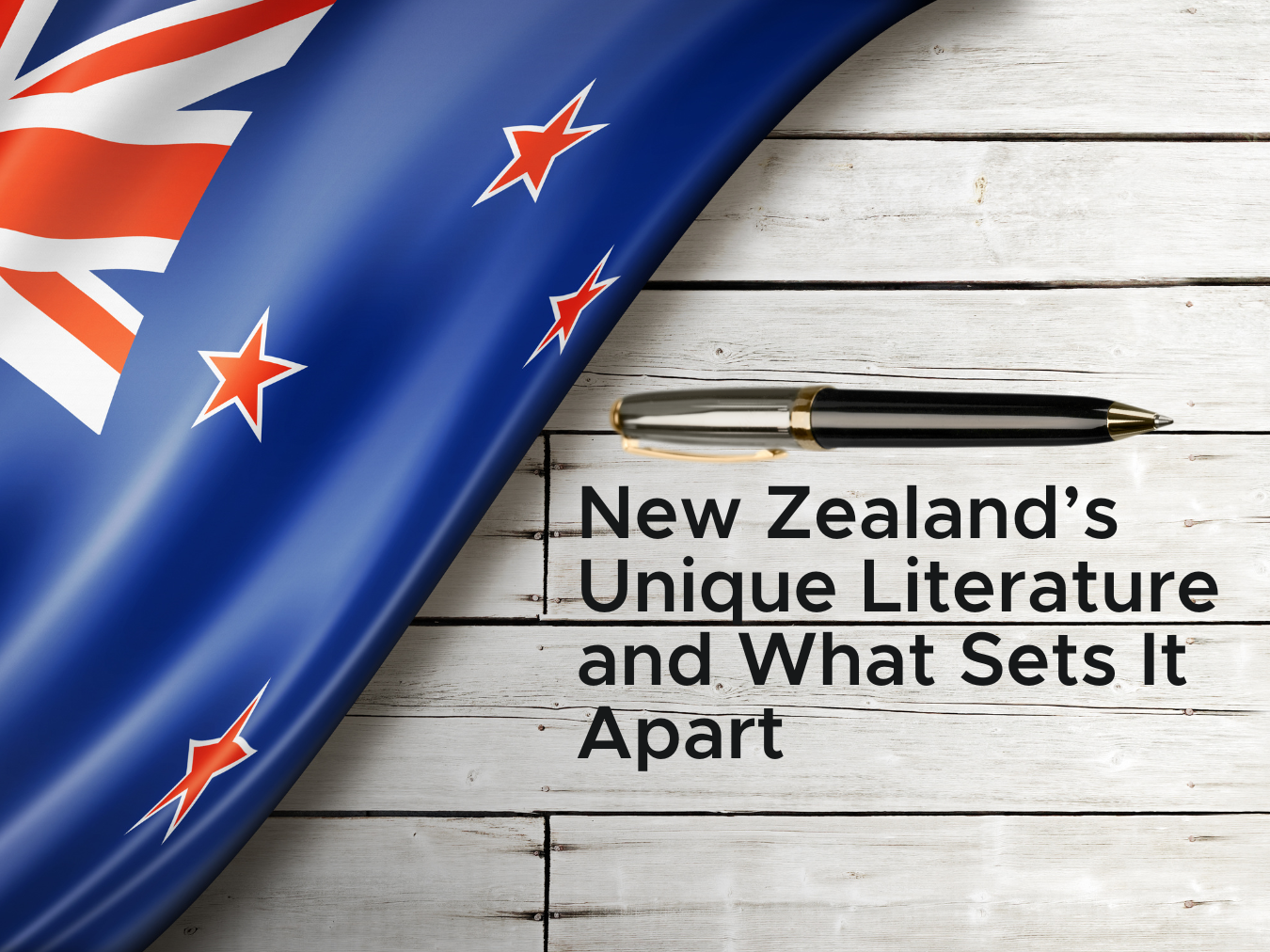What sets New Zealand’s literary scene apart? Well, for one thing, there are distinctive voices in New Zealand literature that have gone on to make contributions to global literature. The distinctive voices in New Zealand literature can be attributed to the unique blend of people on the islands and the isolated nature of the country. The contributions of New Zealand literature to the world are those of ever-evolving themes. New Zealand’s unique literature includes great fiction, non-fiction, and poetry while dealing with politicized issues and national pride.
Distinctive Voices in New Zealand Literature
Like many countries around the world, New Zealand has a colonial history, which means there is complexity to its population.
The first known occupants of the island’s now-known name, New Zealand, were the Māori. These settlers traveled through islands in Polynesia on their way to where they would eventually come home. It is likely that the Māori people were descendants of indigenous Taiwanese people. These people likely traveled around islands such as Tonga, Samoa, Tahiti, Hawaii, and Easter Island before landing in New Zealand and settling there. The Māori are believed to have mainly settled in New Zealand at some stage between 1320 and 1350; however, it’s likely that there were early travelers to the island before a volcanic eruption.
The word Māori translated to English as ‘ordinary’ and was used to distinguish regular people from the gods and spirits that they believed in. Some theorize that the Māori were likely the first people to make it to Antarctica (this is because there is a legend passed down orally in the Māori language that makes reference to an incredibly cold place to the south of New Zealand with descriptions matching those of the icy sea of Antarctica).
The Māori first met the Europeans when explorers from the Netherlands, Britain, and France began to explore Oceania between the mid-1600s and the late 1700s. It appears that a Dutch exploration team under the command of Abel Tasman made the island’s first visit by Europeans in 1642. However, the first Europeans didn’t settle until the 19th century, with nearby Australia being colonized in the decades prior. Whaling was becoming popular, which attracted more Europeans. From the 1800’s onward, the history of New Zealand involved the heavy intermingling of Māori and European cultures. In 1840, New Zealand was brought under the control of the British Empire after a controversial treaty. In the mid-20th century, New Zealand would become independent.
So, there were two major groups of people with a complex relationship: the Māori people and the New Zealanders of European origins. These groups produced unique literature both individually through their own cultures and while being influenced by each other.

Distinctive Voices in NZ Literature: The Māori
What’s interesting about the Māori people and their own mythology and stories is that they originally did not have a literary tradition and did not read or write. The Māori language (called Te Reo Māori) was purely oral. This means that all their communication was done through speaking, and they didn’t write anything down. You can imagine how important clear communication was and how reliable a memory the Māori needed to ensure they were giving each other the correct information. Everything from stories and myths to day-to-day activities to general facts and information had to be remembered and passed around through the spoken word, with nothing being written down. When the Europeans began to settle in the 1800’s, the Māori adapted writing as part of their language. Before this time, it was hard to know much about their history.
A lot of early Māori literature came about through the Europeans collecting books and poems and translating them into English. One of the first notable books based on Māori mythology published in English was Johannes Carl Andersen’s Māori Fairy Tales, which was published in 1908. This book consisted of a collection of Māori myths and legends. At this time, it was still more typical for Māori people to perform stories, songs, and war dances rather than record them, and Europeans were primarily responsible for writing about Māori people.
It wasn’t until after World War II that Māori writers started to spring up, and this writing was largely done in English. In 1964, a poet by the name of Hone Tuwhare published No Ordinary Sun, his first of many books, and in 1966, Saw Jacqueline Storm became the first writer from Māori culture to get published in a major anthology of short stories. Suddenly, Māori writers were starting to appear in the New Zealand pop culture of the time. In the 1980s, schools in New Zealand began to generally encourage learning about Māori culture. Books by a Māori author called Patricia Grace about Māori life were particularly popular in education.
In the 1980s and 1990s, Māori writing proved to be controversial among New Zealanders of European descent, as often it was very political. It was common for books written by Māori authors to touch on the repression of Māori culture. Sometimes, this was a controversial issue among Māori writers too, with Alan Duff, who was the Māori author of Once Were Warriors (later made into a film), saying that it is wrong to be overly sentimental about Māori life. How to talk about Māori culture is a polarizing issue among Māori writers, with differing views on the experience of colonialism and racism and how much integration into European ways is necessary.
In modern times, Māori writing has been promoted more as part of an initiative to promote the culture as a whole. There is a particular focus on publishing in Te Reo Māori and ensuring there are books available in Māori as well as English. Although there are issues around the quality of translation of books from English to Te Reo Māori, there are at least more attempts to get the language out there in a written format.
Distinctive Voices in NZ Literature—New Zealanders of European Descent
A lot of early literature from New Zealanders of European descent that is looked back upon from the 19th century actually weren’t stories or poems but rather journal entries and letters about the experience of living in New Zealand. These involved no fiction and were factual accounts of life on the island’s. Some of the notable pieces in the 1860s and 1870s were A First Year in Canterbury Settlement by Samuel Butler, Station Life in New Zealand by Lady Mary Anne Barker, and Old New Zealand by Frederick Edward Maning.
New Zealand literature started to creep onto the scene in the 20th century, with the biggest voice on the stage being Katherine Mansfield. She was only 34 when she died in 1923, but she had a major influence on New Zealand literature. Her first book of short stories was called In a German Pension; she published it in 1911 and went on to publish Bliss and Other Stories and The Garden Party and Other Stories. She seemed to have a very complicated social life and is mentioned in the writings of famous writers like T.S. Eliot, D.H. Lawrence, and Virginia Woolf. There were two other New Zealand writers of European descent in her lifetime who made an impression: William Satchell and Jane Mander.
A common theme throughout writings from New Zealanders of European descent was colonial life and isolation. One book, Children of the Poor by John A. Lee, was about living in poverty during childhood, and another, called The Godwits Fly, was written by Robin Hyde about isolation in a colonial land. A well-known poet, Ngaio Marsh, is known for her detective novels, which she began publishing at this time in the 1930s.
Another author who began publishing during the 1930s was Frank Sargeson, who wrote fiction. His writing took off after World War II with That Summer and Other Stories, and I Saw in My Dream. His works inspired writers like Maurice Duggan and Janet Frame, who had successful writing careers.
After World War II, there was a shift in the theme of literature to focus more on national pride, which started in poetry with A Book of New Zealand Verse by Allen Curnow. He went on to become a major figure in the New Zealand literary scene. Throughout the 1950s and 1960s, Curnow’s stories and the poetry of James K. Baxter were the most popular names in New Zealand writing. In the 1970s and 1980s, the style of poetry shifted more towards American ideas, particularly modernism and postmodernism. On the other side of things, in the 1960s, two non-fiction authors became popular: Maurice Gee and Maurice Shadbolt.
In the years leading up to the 21st century, short stories were a popular and important form of writing for New Zealanders of European descent. At the same time, there was an increase in the number of biographies that were published. Writing from this group became more diverse, with different areas being touched on.

Contributions of New Zealand Literature to the World
New Zealand’s unique literature features a wide range of themes and topics with excellent storytelling. Here are seven of our favorite contributions to global literature from New Zealand authors.
- The Bone People by Kari Hulme (1983): The story follows three different characters who are all isolated in some way. There is a reclusive artist, a child who is mute, and the foster parent of that mute child. The three characters form a bond but are separated by violence. The novel is unique in that it combines the cultures of Māori and New Zealanders of European descent. The novel was awarded the Booker Prize in 1985 and proved controversial for its themes of violence. While the story is polarizing, it is widely held to be a classic of New Zealand literature.
- In a German Pension by Katherin Mansfield (1911): This is a series of short stories with satirical sketches, often focusing on the differences between the British and the German’s. The book got Mansfield widespread acclaim.
- Once Were Warriors by Alan Duff (1990): The story involves a Māori family living in urban New Zealand. It includes realistic depictions of domestic violence while following two Māori parents and their six children.
- Died in the Wool by Ngaio Marsh (1945): In this story, a well-known woman disappears before reappearing three months later, dead. The book is set on the South Island of New Zealand and was written by one of the most respected crime authors of that period.
- The Haunting by Margaret Mahy (1982): This is a fantasy story where a shy boy learns his family has a connection to spirits and their world. Mahy won a Carnegie Medal when the book was published.
- Owls Do Cry by Janet Frame (1957): The story follows two brothers dealing with money problems, disability, mental illness, and grief, all while trying to find somewhere to belong. This is often referred to as the first great fiction book by a New Zealand author.
- No Ordinary Sun by Hone Tuwhare (1964): This collection of poems was the first of its kind to be published by a Māori author and featured powerful images and political commentary.
In truth, we could fill multiple blog posts with the fantastic contributions of New Zealand literature to the world. The distinctive voices in New Zealand literature have a unique way of sharing a story.
Final Thoughts
What sets New Zealand’s literary scene apart in terms of its contributions to global literature is its unique perspectives. The distinctive voices in NZ literature are shaped by themes of maintaining indigenous traditions, isolation, and colonial life. However, New Zealand’s unique literature has grown over the last century into a representation of New Zealand pride while both covering politicized issues and providing inspiring stories.













